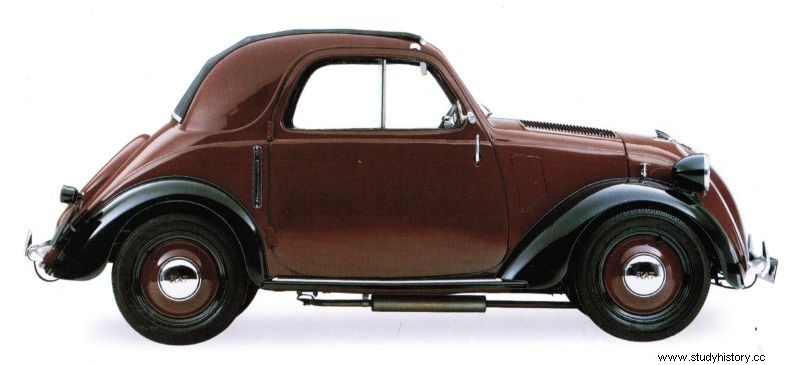Fiat 126p? Mermaid? Sure, these "little ones" had their own character. However, I would rather take a BMW three-wheeler or a ... Messerschmitt microcar. Have a look at some of the lesser-known midges that you may not have heard of yet.
BMW Isetta
BMW is associated with expensive high-end cars, but also has a car "for everyone". After World War II, there was a shortage of people willing to buy luxury models and the company fell into serious financial problems. It was then that the license for the Italian car Iso Isetta was bought, which in the years 1955-1962 was produced under the name BMW Isetta. It did not do much good to the company financially, but it gained great popularity practically all over the world. Interestingly, it was entered from the front (through the hood that also functioned as a door), and the 13-horsepower engine came from one of BMW's motors.

Messerschmitt Tg500
Also, when you hear about the Messerschmitts, fighters from World War II come to your mind? Contrary to appearances, the German concern did not only deal with airplanes. After the war ended, Willy Messerschmitt's company was simply banned from doing so. Necessity is the mother of invention, so the company started to produce ... three-wheeled cars. Their successor was the four-wheeled Tg500, which was already produced by the FMR company, but the car was commonly called the Messerschmitt. It was referred to as a sports car, although from today's perspective it did not knock down its performance to its knees:it accelerated to a hundred in less than 30 seconds, and the top speed was 121 km / h. Contrary to the Isetta, the Tg500 was not intended for a mass audience - only a few hundred copies were made. According to the "Illustrated Encyclopedia. Cars ”was, however, probably the best“ toddler ”ever made.

Citroën 2CV
In the 1930s, almost every European power made it a point of honor to produce a car for the masses. The most famous project of this type was the Volkswagen Typ 1, commissioned personally by Adolf Hitler. We will not write about the "hunchback", because it is a car known to everyone. For comparison, let's take a look at its French counterpart. The Citroën 2CV started to be produced before the war, but its outbreak prevented the car from being available for sale. The idea was resumed in 1948, and production lasted until 1990. It was a car as recognizable on French streets as the Fiat 126p in Poland used to be - almost four million units left the production line. And this despite the fact that in the original version it had a dizzying top speed of 66 km / h ...

Morris Minor
Probably the second most famous microcar in the world, right after the Beetle, is the British Austin Mini. However, this is a model from the very end of the 1950s. The history of the English passion for microcars goes much further. A direct response to the German "People's Car" was the Morris Minor, which even looked like a Volkswagen. It might accelerate to a hundred in a minute or so, but it was perfect for driving around town. Besides, it was said to be well designed, solidly constructed and inexpensive.

Fiat 500 "Topolino"
 You certainly know this model, because Fiat 500 has been produced in Poland since 2007, and quite controversial advertisements from before for a few years they presented it as "part of Polish history". In a way, it really is, because the old Fiat 500 - from 1957-1975 - is the grandfather of our Polish "Maluch". The first Fiat 500, produced before the war (from 1936) and known as the "Mouse" ("Topolino"), is less known. Half a million copies went on sale. As the author of "Ilustrowany encyclopedia. Cars ", it was with this model that Fiat started producing cheap family cars for customers who had never been able to afford their own means of transport before." It undoubtedly drew attention with a more elegant line than most microcars.
You certainly know this model, because Fiat 500 has been produced in Poland since 2007, and quite controversial advertisements from before for a few years they presented it as "part of Polish history". In a way, it really is, because the old Fiat 500 - from 1957-1975 - is the grandfather of our Polish "Maluch". The first Fiat 500, produced before the war (from 1936) and known as the "Mouse" ("Topolino"), is less known. Half a million copies went on sale. As the author of "Ilustrowany encyclopedia. Cars ", it was with this model that Fiat started producing cheap family cars for customers who had never been able to afford their own means of transport before." It undoubtedly drew attention with a more elegant line than most microcars.
Source:
The article is based on the "Illustrated Encyclopedia. Cars ”, which was recently published by Vesper (more information on the publisher's website). All illustrations are taken from this book with permission from the publisher.
See also
- When did blondes go dumb?
- Is the Black Land racist?
- How many bullet holes were there in the Louvre? That is, the defense of monuments in the Anglo-American style
- There was also prohibition in Poland
